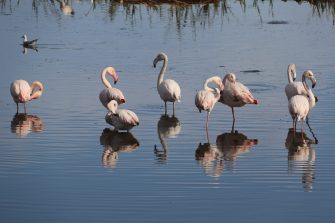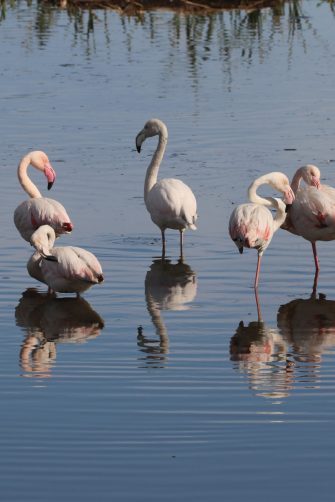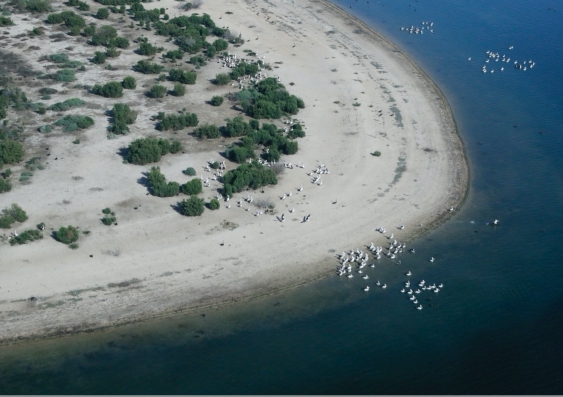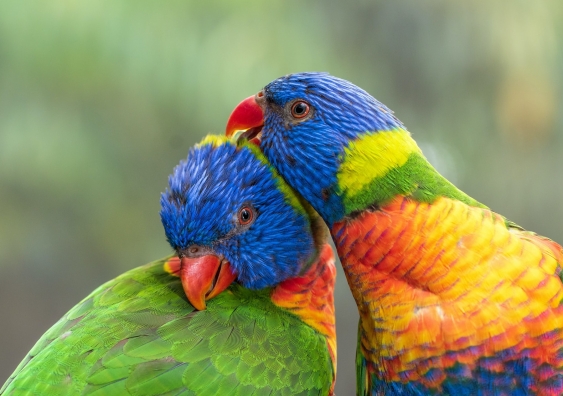Counting half a million flamingos using machine learning helps establish the significant conservation importance of the Makgadikgadi Pans in Botswana.
Scientists from UNSW Sydney’s Centre for Ecosystem Science have found a way to use artificial intelligence to accurately count hundreds of thousands of flamingos in Botswana, making future surveying of numbers of this iconic species – and potentially other bird and mammal species – much easier.
Published recently in the journal Global Ecology and Conservation, the research team estimated there were 532,197 flamingos on the northern basin of Sua Pan, the eastern pan in the Makgadikgadi Pans in Botswana, using aerial photographs collected in June 2019.
The number of flamingos counted in these pans – which are among the largest salt pans in the world – exceeded all historical records in the area since the 1970s, and is the first estimate of flamingos from the area in a decade.
The team used machine learning to estimate the numbers from 3715 photographs taken from a Cessna aeroplane that flew a series of transects across the pans, at a height of 500-600m and speed of 175-195 kilometres per hour. The team needed to control for the overlapping of photographs on the margins and then ‘teach’ the computer to recognise each individual pink dot as a flamingo. This was made challenging by turbulence affecting the stability of the plane.
Importantly the machine learning was just as good as a small sample of photographs counted manually by one of the researchers who poured over the flamingo dots, counting each one.
Sophie Yang, a researcher from the Centre for Ecosystem Science, led the study and developed these new techniques.
“It was quite challenging to organise so many photographs across such a largely featureless landscape,” she said.
“Given some restraints during data collection, we had to partition the dataset to account for the variation in overlap between photographs.”
Ground-breaking method
Citizen scientist Mike Holding made the project possible – with the help of others – by rigging up a plane and flying it systematically across the pans.
“Previous flamingo counts in Botswana have been done manually from photographs – a painstaking and lengthy process. The use of AI technology is ground-breaking for assessing flamingo and other bird species’ numbers,” Mr Holding said.
The team also looked at the importance of this amazing area and its flooding for flamingo conservation. According to researcher Dr Roxane Francis, the team relied on satellite technology to track flooding.
“We were able to use available satellite imagery to investigate the frequency of the pans filling from rivers and local rainfall, giving us a good idea of their likely importance for breeding and feeding flamingos,” she said.
Vast concentrations of flamingos are spectacular and one of nature’s wonders but also of major significance for conservation. Professor Richard Kingsford, one of the authors, summed up the challenge and opportunity presented by the new study:
“This work really allows us to tackle the conservation of the Makgadikgadi Pans and its flamingos, an Important Bird Area (IBA), including the Makgadikgadi Pans and Nxai Pan National Parks,” he said.
“We need to protect the flooding regime, by making sure water from the Nata River in the north and other rivers to the Makgadikgadi Pans, such as the Boteti River are maintained.”
Two flamingo species occur in Africa, the lesser flamingo Phoeniconaias minor and greater flamingo Phoenicopterus roseus. These iconic pink birds live on large salt lakes and filter feed on microscopic algae and tiny invertebrates. They do this by straining the water with heads upside down and catching their food with specialised comb-like structures lining their beaks, much like whales.
These fragile environments must be protected if we are to conserve these incredible birds, which are an important part of these rare ecosystems and a major tourist attraction.
Near Threatened
From past observations of breeding, Sua Pan is one of the most important breeding sites for flamingos in Africa. For lesser flamingos especially – which are Near Threatened on the IUCN Red List of Threatened Species – the pans are one of only six major breeding sites. The flamingos observed in June 2019 were feeding, rather than breeding, highlighting Sua Pan’s ability to support huge concentrations of individuals outside of breeding attempts.
The significance of Sua Pan as key flamingo habitat in southern Africa and beyond reinforces the need for its ongoing protection. Successful breeding requires very special conditions, including the right amount of flooding to create islands of salty mud for raising chicks, isolated from predators.
There is currently insufficient protection of the Makgadikgadi Pans from adventure tourism developments, dam building upstream and other human-related threats.
“These fragile environments must be protected if we are to conserve these incredible birds, which are an important part of these rare ecosystems and a major tourist attraction,” said Professor Kingsford.
Regular monitoring is necessary for ensuring the continued suitability of Sua Pan as feeding and breeding habitat. The researchers hope that their machine learning method, used to count birds in aerial photographs, will help this cause, as traditional methods for counting such large numbers are usually tedious and time-consuming.
This work builds on the collaboration underway between researchers at the University of NSW and researchers and citizen scientists in Botswana.








